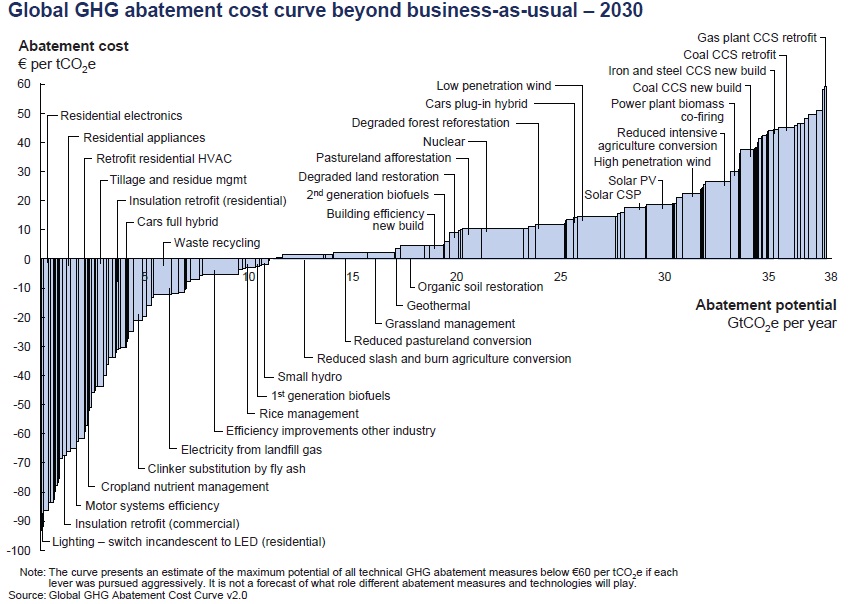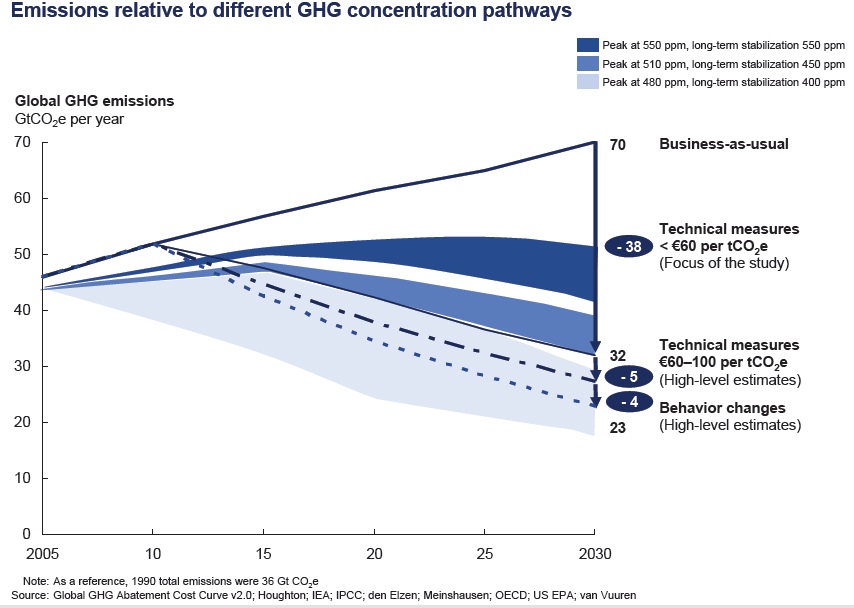In my last entry, I pointed to the argument that the committed fund for climate change mitigation and adaptation is nowhere near what is needed to meet the target of limiting temperature rise to 20C by 2030. Within the past few days of negotiation here at COP15, Africa Union has lowered its requested financial support to make an agreement more feasible. Today Hillary Clinton pledged an amount of US$100 billion from developed world for climate finance by 2020, which is at the low end of what is expected. Both sides are moving toward compromising on a lower finance level. After COP15, it is almost certain that funding for climate change mitigation and adaptation will not increase that much. With limited money, what sectors and areas should we focus on to achieve the most impact?
At least three climate finance side events that I have been to here cited the McKinsey Global GHG Cost Curve as a reference for quantifying the cost of limiting climate change. This 192 page report was published by McKinsey, a consultancy, in 2009 after extensive evaluation of 200 greenhouse gas abatement opportunities in 10 sectors and 21 world regions. Using a consistent formula, the report quantified the cost and impact of each abatement method. Despite many assumptions made by the report to arrive at a high level of consistency, it added tremendous value by analyzing methods using concrete quantification. I think this is extremely helpful amidst all the talk about different ways to limit climate change at COP15 such as efficient buildings, hybrid cars, efficient home appliances, solar panels, geothermal, and even vegetarian diet. Each method has its merits. In an ideal world maybe all of them should be implemented. Yet, with limited finance as we have seen in reality, prioritizing methods with the most impact at the lowest cost would be preferable.
(Wider bars indicate bigger impact. Higher bars indicate higher cost)
According to the McKinsey cost curve, methods with negative cost (resulting in saving) include LED lighting, insulation retrofit, cars full hybrid, waste recycling and motor system efficiency among others. High cost methods are gas plant CCS retrofit, power plant biomass co-firing, nuclear energy, etc. Those are all technology-based abatement methods.
Compared to technical measures mentioned above, behavior changes have much lower impact, with a full potential of reducing about 5 gigaton of CO2 equivalent per year by 2030. McKinsey, however, made it clear that this impact level was arrived at under the assumption that all technical measures would be implemented before any behavior changes. In reality, if technology is not pursued to its full potential, behavior changes may have bigger impact. Nevertheless, based on this report, behavior changes have much lower abatement potential than technical measures.
My last comments: first, this report is very popular among both NGOs and businesses at COP15 and second, strategy consultancies such as McKinsey often set business trends.
Tags: adaptation, Climate Finance, Luan Nguyen, McKinsey Abatement Cost Curve

